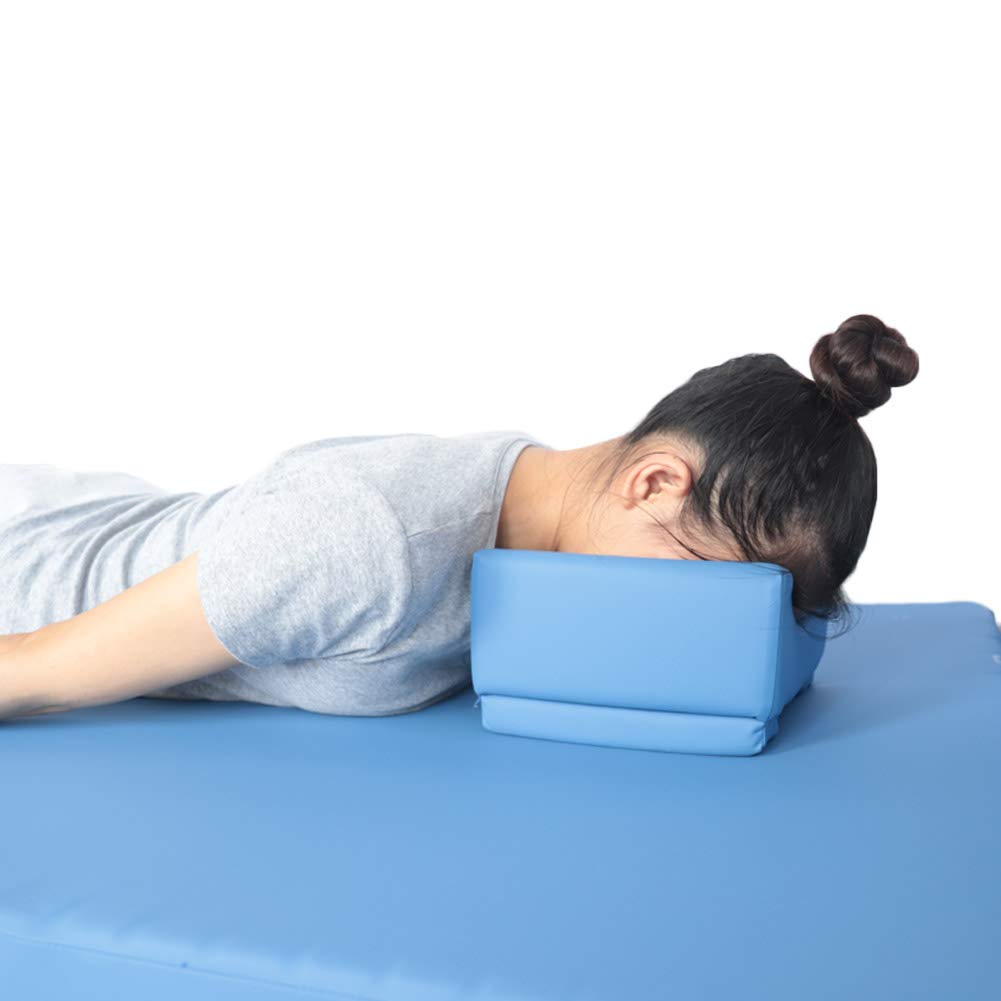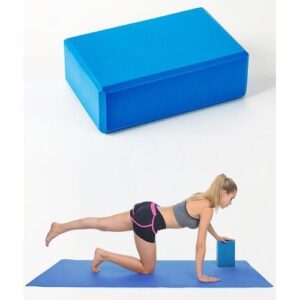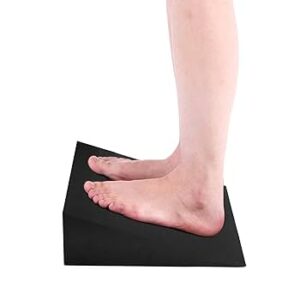

Improving posture does not have to involve complex machines or expensive gear. Sometimes, a small, angled foam wedge is all it takes to make a big difference.
Postural wedges help shift your body into better alignment during common exercises, making each movement more effective and therapeutic.
Whether you are standing, sitting, or lying down, wedges can subtly change joint angles, improve muscle activation, and promote awareness of your body’s positioning.
Physical therapists, trainers, and chiropractors often use wedges to correct imbalances and retrain poor habits.
In this article, Best Forward Head Posture Fix shall explore six practical ways to integrate a wedge into your daily posture routine.
Each section is based on recent scientific research and expert recommendations, with examples you can try at home.
From foot balance work to neck support, these methods can help you unlock better posture—one wedge at a time.
Points Covered in this Article”
- Standing Balance Boosters with Foot Wedges
- Squat and Lunge Enhancers Using Wedges
- Sitting Posture Correction with Pelvic Wedges
- Neck and Thoracic Mobility with Cervical Wedges
- Integrating Wedges into Core Stability Work
- FAQs on Wedge for Posture Correction
- Personalized Wedge Routine & Safety Guidelines
Standing Balance Boosters with Foot Wedges
Using foot wedges while standing is one of the easiest ways to improve your balance and posture at the same time.
When you stand on a wedge that tilts your foot either inward (medial) or outward (lateral), it causes slight shifts in how your body maintains balance.
This activates different muscles in your feet, ankles, and hips—especially those responsible for stabilizing your center of gravity.
To get started, place a small wedge under one foot and stand near a stable surface like a countertop or wall. Maintain a tall spine and let your body adjust to the shift. You would likely feel your ankle and hip muscles engage in new ways.
Try holding the position for 30 seconds per side, and then gradually build up to a minute. As your balance improves, you can challenge yourself further by closing your eyes or moving your arms.
This kind of practice trains your brain and muscles to react better during real-life activities—like walking on uneven ground or standing on a moving train. Over time, your overall balance improves, and your body becomes more efficient at staying upright with less strain.
To minimize pain in the neck and upper back learn to place your wedge pillow properly.
hose recovering from injury, these exercises can even help reduce fall risk. For athletes or fitness enthusiasts, it is a simple tool to build stability and foot control. Best of all, it only takes a few minutes a day.
Squat and Lunge Enhancers Using Wedges
Squats and lunges are go-to exercises for strengthening your lower body, but they can be even more effective when performed with a wedge.
Placing a wedge under your heels—what is called a posterior foot wedge—changes the angle of your ankle, making it easier to stay upright during the squat.
The best part here is that orthotics helps neck alignment therefore minimizing the chances of text neck posture.
This adjustment reduces forward lean and places more emphasis on the quads, especially the inner thigh muscle (vastus medialis), which is often underused.
If your calves are tight or you struggle with ankle mobility, a heel wedge can make squatting feel more natural.
You would likely notice that you can go deeper into the movement without your heels lifting off the floor. For lunges, this same setup can help maintain knee alignment and reduce pressure on the back leg.
On the flip side, placing a wedge under the forefoot (anterior wedge) shifts your weight forward and increases activation in the glutes and hamstrings. This variation can be useful for targeting the backside of the legs and improving hip extension.
To incorporate wedges into your lower-body workout, start with 2–3 sets of 8–12 reps. Alternate between wedge positions to train different muscle groups and movement patterns.
Whether you are training for performance, rehab, or general fitness, wedge-enhanced squats and lunges provide targeted benefits while promoting better form and posture throughout the body.
Sitting Posture Correction with Pelvic Wedges
Many of us spend hours each day sitting, often in positions that strain the spine and flatten the natural curve of the lower back.
Enter the pelvic wedge—a simple cushion angled slightly forward that helps restore proper alignment in a seated position.
These wedges are often used in schools, offices, and therapy settings to improve sitting posture without requiring constant reminders.
So, using wedge pillow during desk work can improve your neck posture thereby minimizing neck and upper back pain.
When you sit on a forward-tilting wedge, your pelvis naturally tilts anteriorly.
This encourages a neutral spine, gently restoring the natural curve in your lower back (lumbar lordosis).
It also reduces the tendency to slump or round the shoulders forward.
Over time, using a pelvic wedge can help retrain your muscles to maintain better alignment even when you’re not actively thinking about it.
To use one, place a 5–8 degree wedge on your chair. Sit with both feet flat on the ground and your hips slightly higher than your knees.
Your weight should rest on your sitting bones—not your tailbone or low back. This position helps engage your core muscles while reducing stress on the spinal discs and ligaments.
You can take it a step further by incorporating gentle movement. Perform seated pelvic tilts or thoracic extensions while sitting on the wedge. These micro-movements help prevent stiffness and promote spinal mobility.
Pelvic wedges are especially useful for desk workers, students, and drivers who spend extended periods sitting. They provide a passive, yet powerful, solution for maintaining upright posture throughout the day.
Neck and Thoracic Mobility with Cervical Wedges
Forward head posture and rounded upper backs are common issues in our digital age, but cervical wedges can offer a gentle and effective solution.
These foam wedges are designed to support the natural curve of the neck (cervical lordosis) when lying down. When used consistently, they can help reverse years of poor posture and relieve tension in the neck and shoulders.
To begin, lie on your back with a cervical wedge placed under your neck so that your head tilts slightly backward. Let your arms rest comfortably by your sides and focus on slow, relaxed breathing.
Start with just 3 to 5 minutes and gradually work up to 10. This simple passive stretch allows tight muscles in the front of the neck and chest to relax, while gently encouraging proper alignment of the cervical spine.
You can enhance the experience by adding light movements like chin tucks or scapular retractions. These help activate deep neck flexors and upper back muscles, which are essential for maintaining upright posture.
Using a cervical wedge daily can lead to noticeable improvements in neck mobility, posture awareness, and tension relief. It’s a great tool for anyone who works at a computer, looks down at a phone frequently, or suffers from chronic neck stiffness.
Just remember: it is not about forcing the curve into place—it’s about inviting your body to remember its natural shape. Think of it as yoga for your spine—quiet, focused, and restorative.
Integrating Wedges into Core Stability Work
Core stability is the foundation of good posture. It helps keep the spine aligned and the body balanced during movement.
Wedges can be a powerful addition to your core routine by changing the angle of support and adding a subtle instability that challenges your muscles to work harder.
One simple example is the pelvic bridge. Placing a wedge under your heels during this exercise shifts the emphasis toward your glutes and lower back.
As you lift your hips off the ground, you would feel greater activation in your posterior chain, which supports a more balanced posture.
For exercises like bird-dog, placing a wedge under the supporting knee or hand increases proprioceptive demand. This means your body has to work harder to stay stable, engaging deeper core muscles that often go underused.
Planks can also benefit from wedge placement. Elevating your toes with a forefoot wedge increases the challenge to your anterior core and leg stabilizers. Just be sure to keep your spine neutral and avoid letting your hips sag.
You don’t need a long session—just a few wedge-modified moves added to your routine can make a difference. Aim for 3 sets of each movement, focusing on control and alignment rather than speed.
Over time, this builds a stronger, more responsive core that supports upright posture during everyday tasks like walking, standing, and even sitting.
Personalized Wedge Routine & Safety Guidelines
As with any posture training tool, using a wedge should be tailored to your needs. What works for one person may not be appropriate for another, especially if you have mobility limitations, previous injuries, or specific alignment issues.
Start small and build gradually.
Begin by selecting one or two posture areas to target—such as standing balance or seated alignment. Use a mild incline, typically 5 to 10 degrees, and focus on short sessions (5 to 10 minutes). Assess how your body feels afterward.
Are certain muscles more active? Do you feel more aligned or balanced?
As you grow more comfortable, you can introduce multiple wedge positions across your day—maybe a heel wedge in your squat workout and a pelvic wedge during work hours.
Keep a journal or mental note of which angles and positions feel best for your body.
A few safety tips:
- Never push through sharp pain. Discomfort is okay, but pain is a red flag.
- Use stable surfaces and supports when starting out with standing wedge exercises.
- Take rest days or alternate routines if you feel sore or fatigued.
- Always consult a physical therapist or healthcare provider if you have chronic pain in the upper back, spinal issues, or postural deformities.
When used thoughtfully, wedges are a low-cost, high-impact addition to your daily posture routine. They can be integrated seamlessly into almost any setting—at home, at the gym, or even at your desk.
With consistent use and attention to detail, you would find your body adapting to a more upright, balanced, and confident posture.
FAQs on Wedge for Posture Correction
Q-1: Which wedge should I choose for posture work, and how do I size it?
A-1: For most routines, pick a medium-density foam wedge (20–30° incline). Thoracic mobility responds well to a 6–10 cm height; calf/slant work needs 20–30°. If you’re petite or hypermobile, start smaller; if you’re broad-chested or very stiff, go larger. A quick check: when you lie or stand on it, you should feel a gentle stretch without bracing, tingling, or holding your breath.
Q-2: How do I use a wedge to mobilize a stiff upper back without cranking my neck?
A-2: Lie on the floor with the wedge’s high edge under your mid-back (not the neck). Support your head with a small towel so the chin stays slightly tucked. Breathe low and slow for 4–6 breaths, then slide the wedge one vertebra lower and repeat (2–3 positions total). Keep ribs “heavy” and abs lightly engaged to avoid excessive lower-back arching.
Q-3: What’s a simple daily routine to pair the wedge with scapular setting?
A-3: Try the “Wedge + Wall Angel”: sit against a wall with the wedge behind your mid-back (point up). Feet 30–40 cm out, pelvis neutral. Press elbows/wrists to the wall, slide arms up 10–15 cm, then down—no rib flare. Do 2 sets of 6–8 slow reps. Finish with 30 seconds of pec doorway stretch so the new thoracic extension sticks.
Q-4: Can a wedge fix my desk posture while I work, or is it only for exercise blocks?
A-4: It can cue posture in short bouts. Place a thin sitting wedge (front low, back high) under your hips to encourage a slight anterior pelvic tilt; use it for 20–30-minute sessions, not all day. Keep screen at or just below eye level, elbows close, and feet flat. If your chin starts to jut, raise the monitor or enlarge text—don’t add more wedge height.
Q-5: How do I use a slant-wedge to ease forward-head tension from tight calves?
A-5: Stand on a calf slant board (or wedge) facing uphill. Soften knees, stack ribs over pelvis, and keep a light chin tuck. Hold 30–45 seconds, 2–3 times per side. The goal isn’t a maximal stretch; it’s restoring ankle dorsiflexion so your torso doesn’t compensate by tipping forward—often a hidden contributor to neck strain during walking and standing.
Q-6: What safety checks should I run before adding a wedge to my routine?
A-6: Skip painful end-ranges: you should feel mild-to-moderate stretch, not sharp pain, tingling, dizziness, or nausea. Avoid placing the wedge beneath the cervical spine; target the upper back or hips instead. Progress volume before angle: add reps/breaths for a week, then increase height by 1–2 cm. If you have osteoporosis, recent surgery, or radiating arm symptoms, get clinician guidance before starting.
Conclusive Analysis:
Wedges may be small, but their impact on posture is anything but minor. Whether you are standing, sitting, stretching, or strengthening, these simple tools can transform the way your body moves and feels.
By incorporating wedges into daily posture exercises, you give your muscles the stimulus they need to activate properly, and your spine the support it needs to stay aligned.
Forward neck bent is fixed via wedge pillows, if you learn to place them properly. Just a few minutes a day can lead to lasting improvements in balance, mobility, and comfort.
So grab a wedge, pick a posture focus, and start reshaping your alignment—one angle at a time.
References:

